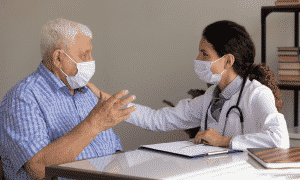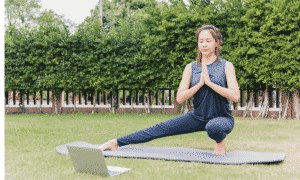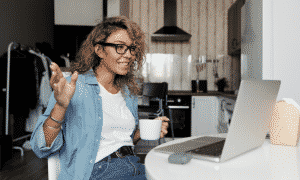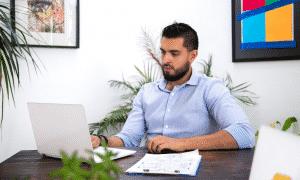4 Healthy Ways to Cope with Anxiety
At the beginning of 2020, no one could have predicted that a global health emergency would change our lives from where we work to who we can see socially and the kinds of things we can do recreationally. The virus has also changed how we eat, shop for groceries, and increased the potential for an even more sedentary lifestyle.
Anxiety and feelings of anxiousness that persist long-term can significantly compromise immune system functioning. And the last thing any of us wants right now is to do anything to weaken our immunity, particularly during the Covid-19 pandemic.
We would like to share four healthy self-care methods and ideas you can use to address anxiety symptoms at home after speaking with your primary care provider (PCP) or practitioner.
1. Talk to Your Doctor and Complete an Anxiety Inventory
There are many different levels of anxiety. For some, the anxiety of social distancing and navigating the Covid-19 coronavirus present something new. People who have never experienced significant symptoms of anxiety are now speaking with their physicians about a new mental health concern.
The American Psychiatric Association (APA) reported in 2020 that 40% of Americans are anxious about becoming seriously ill from the Covid-19 coronavirus. But in the same survey, 62% of Americans said they were anxious about the possibility that a loved one would get Covid-19.
How do you know whether you have circumstantial or short-term anxiety or clinical anxiety? The  approach to treating both is similar. First, visit your doctor’s office and talk to your practitioner about your symptoms. Many physicians will ask you to complete an anxiety and depression scale. Think of it as a multiple-choice test where there are “no wrong answers,” just honest about how you feel daily.
approach to treating both is similar. First, visit your doctor’s office and talk to your practitioner about your symptoms. Many physicians will ask you to complete an anxiety and depression scale. Think of it as a multiple-choice test where there are “no wrong answers,” just honest about how you feel daily.
Using a test like the Beck Depression Inventory, your physician will be able to measure how disruptive and severe your anxiety symptoms are. If you score in the mild range, your physician may offer some holistic solutions to help alleviate the symptoms. Some of those measures can include exercise, yoga and meditation, dietary changes, and reduced media (screen) time.
After completing the depression and anxiety scales, some patients get a very high score. In those circumstances, doctors may suggest taking an antidepressant or anti-anxiety medication. Even a mild or low dose of anti-anxiety medication can help patients reduce stress levels.
2. Get Outside and Exercise Daily
Being responsible right now, and doing your part during the pandemic, means social distancing. By now, most people have a very hefty case of ‘cabin fever.’ And if you live in an area where the weather is not great right now, going outside may be the last thing you want to do.
Staying indoors for long periods of time means a higher level of inactivity. Most of us already cleaned our closets and organized our garages months ago, desperate for something to do during the shut-down. After over a year of social distancing, most days are sedentary, but that is not good for our physical or mental health.
Exercise is one of the best and least expensive ways of coping with anxiety. We do not think of exercise first when we are stressed because of mental fatigue. When we are worrying, upset, or feeling insecure, it burns a lot of brainpower. Subsequently, we can feel mentally fatigued and think that the body is also tired, but rarely is that the case.
Sometimes it is hard to get moving when you have a lot on your mind. Just remember that after any physical activity, the body releases endorphins and hormones like serotonin. That is the natural “runner’s high” that everyone gets after working out. Just getting outside for a short walk can boost your mood considerably. Start slow, try 10 minutes of physical activity, and slowly build up to at least 30 minutes of moderate physical activity per day. Exercise is an excellent antidote for anxiety and feelings of low mood.
Here are a few suggestions that can get you outside safely and increase the amount of exercise you get every day:
- Order your groceries for pick-up instead of delivery. It is still safe (wear your mask!), and the chances are that someone from the grocery store will load up your purchases in the truck. However, the act of getting outside and moving can make a big dif
 ference.
ference. - Plant a garden. Once the warm weather is here, think about planting a flower or vegetable garden. It will give you a daily excuse to go outdoors, soak up some natural vitamin D, and provide relief from stress. According to some clinical studies, getting your hands in the soil can substantially reduce hypertension (high blood pressure).
- Go to Yoga! Of course, many studios are closed right now for health precautions, but there are plenty of yoga classes are on YouTube. In fact, #YouTubeYoga is a thing! So, grab a mat, keep it near your television, and make healthy stretches part of your schedule every day. And if you want to get outside, grab your laptop and head to the patio to exercise.
3. Create a Schedule for Video Visits with Family and Friends
You are missing your family and friends. But you do not want to bother them by contacting them all the time? Your family and friends are missing you too. And it is not a bot her, but rather a great opportunity to fill your internal “social happy meter” with some visits the best way you can. And for most of us, that means jumping on Skype, Facebook Messenger, or Zoom.
her, but rather a great opportunity to fill your internal “social happy meter” with some visits the best way you can. And for most of us, that means jumping on Skype, Facebook Messenger, or Zoom.
Jump into your Outlook or Google Calendar. Send some invites. You know the best times to reach those you care about most. Be proactive and make those social visits by video happen. Social isolation is a common challenge while social distancing. Your friends and family will also benefit from the visit and by staying connected.
4. Build a ‘Fake Commute’ Into Your Day
If you are fortunate to work from home, you may feel some emotional malaise setting in. You miss your desk and office. Your co-workers. The lady in the other department who makes banana bread and brings it in all the time. There is an ebb and flow to our week that is driven by our normal work routines.
But now, instead of hopping in your car or grabbing a commuter train and a coffee on the way to work, you are just walking to another room in your house. That commute from your bedroom to the kitchen, then to your desk is not nearly as exciting. It can make you feel like every day is the same, and some people can feel like they are losing their sense of time and space.
Take back your commute. Some psychologists have suggested the best way to beat the “work from home blues” is to recreate your original commute. No, you do not have to drive to the office. But wake up, get ready, and then leave your home in the morning as you would on the way to work. Walk a couple of blocks and return to your house. Then repeat, at 5:00 p.m.
This is a self-care strategy that is working well for some people during the pandemic. Mostly because it breaks up the monotony of no-commute and invigorates the brain by becoming active first thing in the morning, some professionals have also suggested that the ‘fake commute’ strategy also helps them draw a line and maintain a better life balance. Your nighttime commute will signal the end of the day and an essential shift from work to home-time.
If you know someone who is struggling with anxiety, share this article and ideas with them. Remember, if your symptoms of stress persist or feel unmanageable, make an appointment with your family doctor. Dietary deficiencies and other medical conditions can also mirror circumstantial anxiety. Your physician can help you determine self-care strategies, supplements, and possible medications that can help. The amount of time you spend on your devices can also negatively effect your mental health.



















